2.6 ATP Synthesis & Electron Carriers + 2.7 Glycolysis + 2.9 ETS
1/22
Earn XP
Description and Tags
DIAGRAMS ABOUT THE STEPS OF CELLULAR RESPIRATION NOT IN FLASHCARDS, LOOK AT SLIDES
Name | Mastery | Learn | Test | Matching | Spaced |
|---|
No study sessions yet.
23 Terms
What is the source of energy for all organisms?
The sun
What is the only type of energy that organisms can use?
Chemical
What are electron carriers?
Molecules that are easily reduced and oxidized in coupled reactions
What is NAD?
A biological electron carrier
Derived from vitamin B1-12
Carries H+ and e- to electron transport system where they are used to produce ATP
Easily reduced to NADH and oxidized to NAD+ releasing energy
NADH → NAD+ + H+ + 2e-

What is FAD?
A biological electron carrier
Derived from Vitamin B2
Carries H+ and e- to electron transport system where they are used to produce ATP
Easily reduced to FADH2 and oxidized to FAD releasing energy
FADH2 → FAD + 2H+ + 2e-
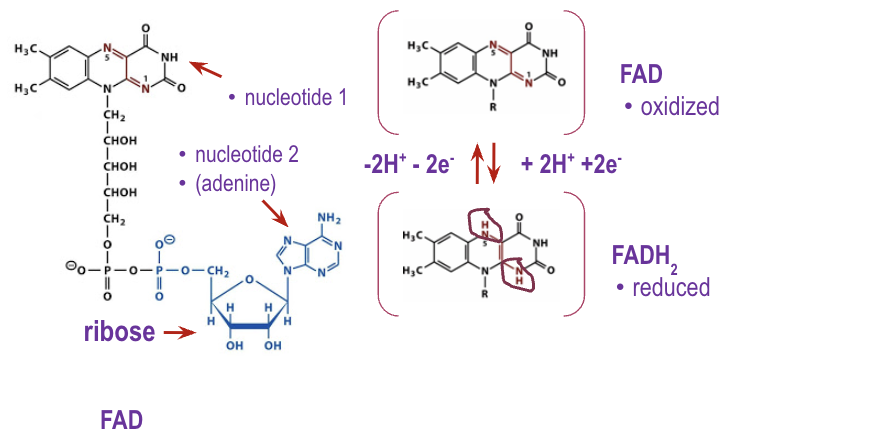
What is coenzyme A?
A molecule that contains a sulfhydryl group derived from vitamin B2
Brings the acetyl group from transition reaction into the Krebs Cycle
Allows acetyl group to bind to the first enzymes of the Krebs Cycle
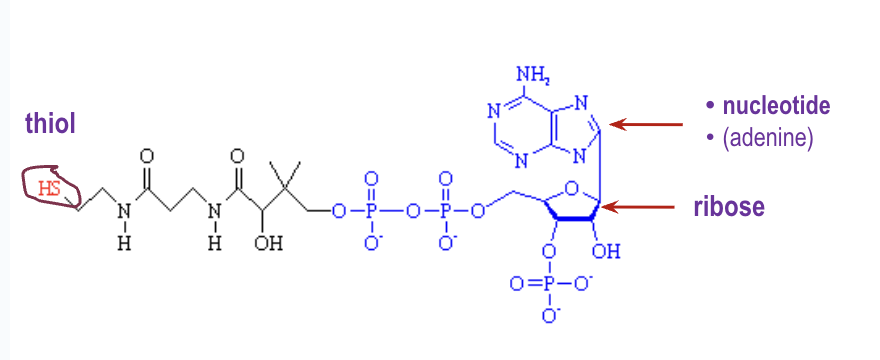
What are porphyrins?
Globular proteins
4° structure
Contains cofactors (metallic ions)
Metallic ions are within a tetrapyrrole ring (4N within C rings)

What is substrate-level phosphorylation?
A type of ATP synthesis
The substrate molecule donates its P to ADP to make ATP
Coupled reactions:
Substrate~P → Substrate + P + energy
ADP + P → ATP
The limitation is that only one ATP is produced at a time
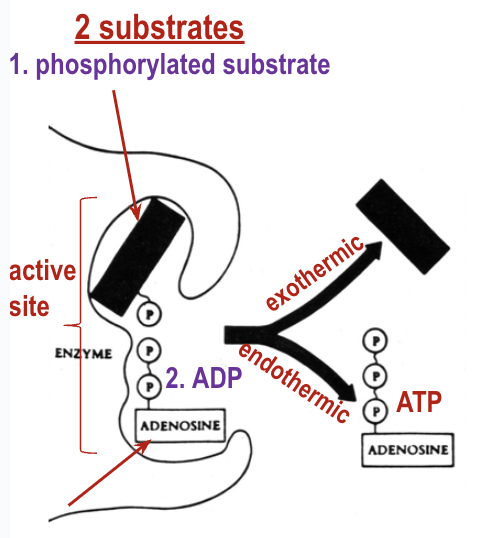
What is oxidative phosphorylation & chemiosmosis?
The generation of ATP due to H+ ions moving across a proton channel down their concentration gradient
The concentration difference over the membrane results in both a chemical and electrical difference across the membrane known as electrochemical gradient
The flow of protons back into the matrix of the mitochondria via a proton channel provides enough energy for ADP to combine with P forming ATP, catalyzed by the enzyme ATP synthase
Oxygen combines with H and is reduced to water
Occurs on the surface of the inner mitochondrial membrane (on the cristae)
Uses proton pumps and proton channels
How does oxidative phosphorylation & chemiosmosis use proton pumps?
Actively transports H+ into the intermembrane space out of the matrix
Builds a protein gradient across the membrane
High concentration of H+ in the intermembrane space
Low concentration of H+ in the matrix
Proteins are positively charged, therefore repel
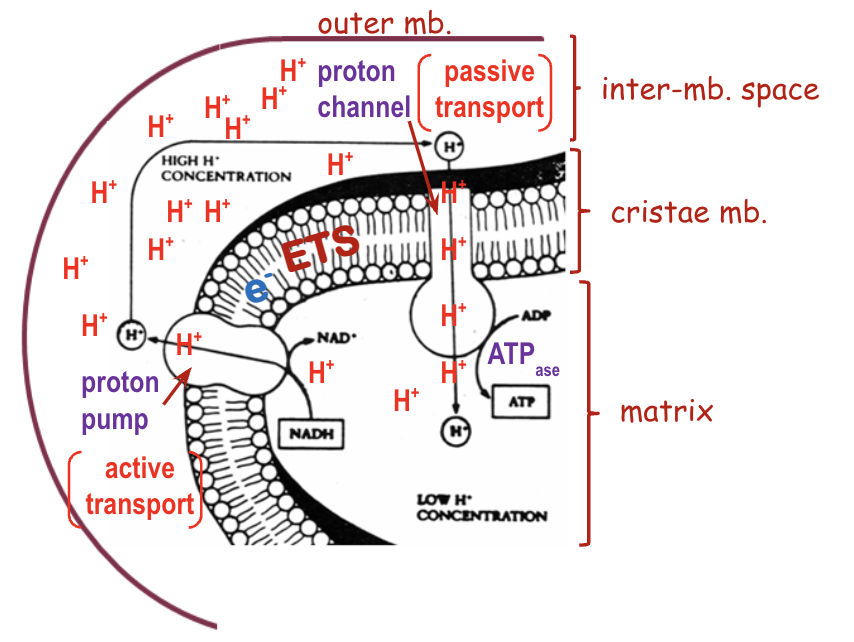
How does oxidative phosphorylation & chemiosmosis use proton channels?
H+ escapes through the channel
H+ diffuses through passively from high to low concentration
H+ flows through of the activates ATP synthase to help bond ADP + P → ATP
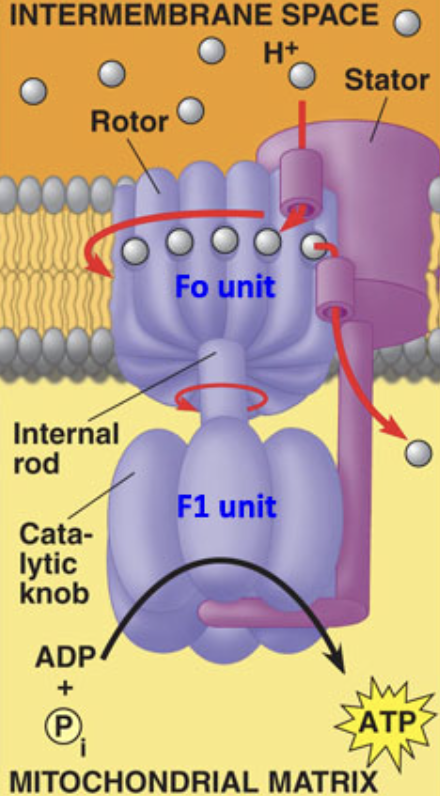
What is cellular respiration?
A series of reactions carrying out the controlled oxidation of glucose
C6H12O6 + 6O2 →→→→ 6CO2 + 6H2O + 36 ATP
Each arrow represents the four stages of the reaction
What happens by the end of cellular respiration?
C6H12O6 has been completely oxidized
O2 has been reduced to H2O
Net gain of 36 molecules of ATP
What are the four stages of cellular respiration?
Glycolysis
In the cytoplasm
Anaerobic
Transition reaction
In the matrix
Krebs cycle
In the matrix
Electron transport chains
In the cristae of mitochondria
What is the purpose of glycolysis?
To break down glucose into pyruvate
1 glucose is broken down into 2 pyruvate
Has a net gain of 2 ATP
What is the transition reaction?
A reaction that involves a series of oxidative decarboxylations
Breaks down pyruvate into acetyl coA
2 pyruvate make 2 acetyl coA
It links glycolysis to Krebs
Involves a protein embedded in the inner membrane
What are the 3 coupled reactions in the transition reaction?
CO2 removed from pyruvate (decarboxylation)
Pyruvate is oxidized, while NAD+ is reduced
Acetyl group is transferred from CoA → Acetyl CoA
The reactions are catalyzed by pyruvate dehydrogenase complex
What is the purpose of krebs cycle?
To oxidize acetyl CoA to produce energy
High-energy electron carriers such as NADH and FADH2 are generated
Carbon dioxide is released as a byproduct
What is the purpose of ETC?
To create a concentration gradient across the inner mitochondrial membrane, which drives the production of ATP through oxidative phosphorylation
As one protein is reduced, the previous one is oxidized as e-’s move down the chain releasing energy to pump H+ into the intermembrane space
At the end, O2 is the final electron acceptor and joins with H+ to make H2O
What is the purpose of ATP synthase?
To make ATP
As electrons are passed along the ETC, they release energy that is used to pump protons (H+) out of the mitochondrial matrix, creating a concentration gradient
This gradient is then used by ATP synthase to synthesize ATP as protons flow back into the matrix
What happens when O2 is not present when doing glycolysis in HUMANS?
Lactic acid fermentation
NADH is recycled into NAD+
Produces lactic acid
What happens when O2 is not present when doing glycolysis in YEAST?
Alcohol fermentation
NADH is recycled into NAD+
Produces CO2 and Ethanol
Why is lactic acid and alcohol fermentation important?
So that it can restart or continue to do glycolysis and produce ATP until oxygen levels are back to normal